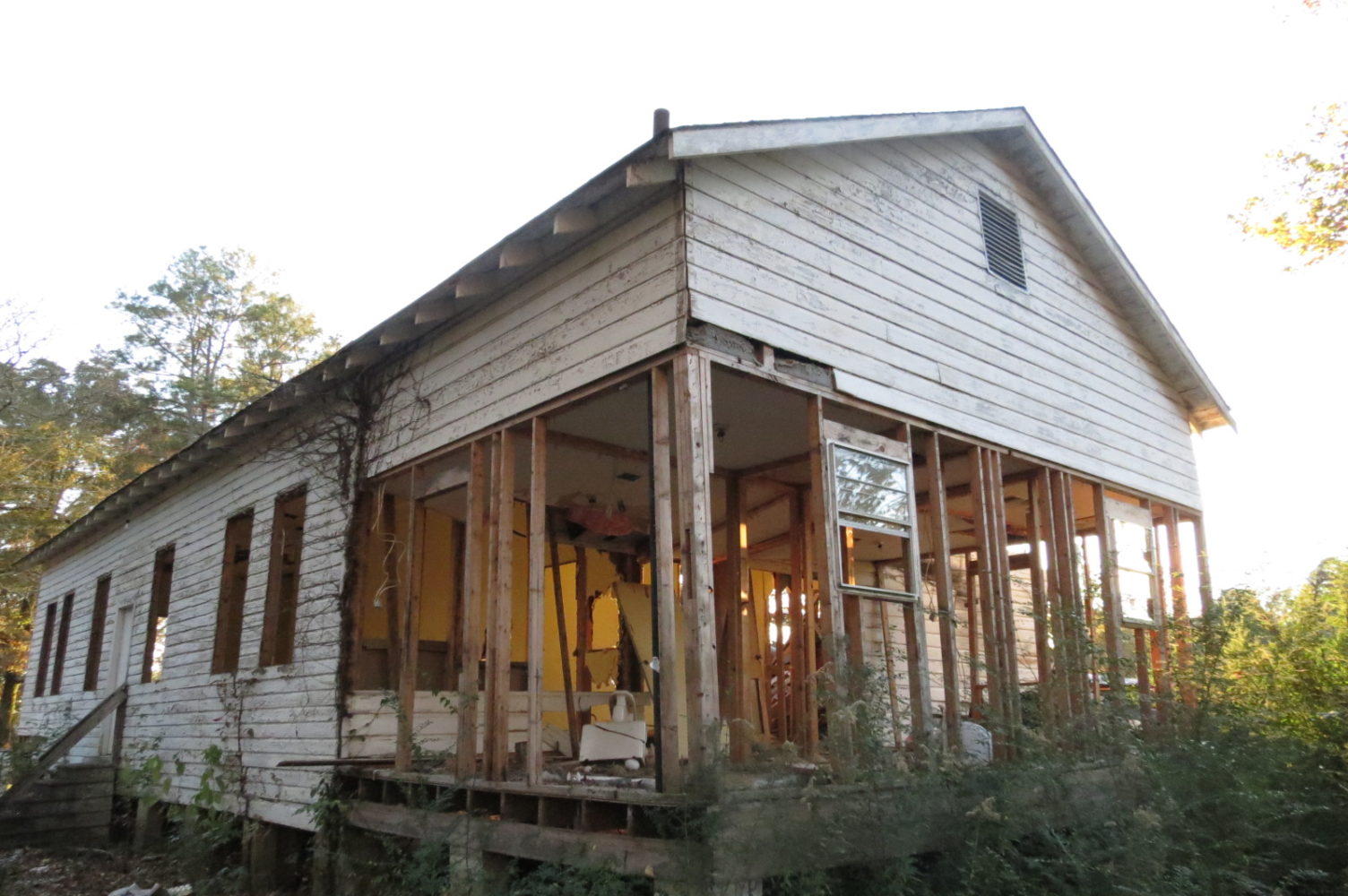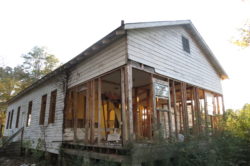Parish Spotlight
Byway Blues
Mable John and the power of home
Published: December 3, 2018
Last Updated: June 1, 2023

Photo by Lila Strode
Ruins of Washington Chapel, where Mable John was christened in 1931.
About a century ago, a pond separated Monroe from Bastrop. The landscape has changed—highways now run alongside the water—but the people are the same. Tenacious. They establish roots as deep as those of the surrounding pine trees. One of these loggers—a log roller, actually—was Mertis John.
“As the trees were cut down,” recalled his daughter Mable, “they would fall over into the pond. The log rollers would roll those logs with their feet right up to what we would now call a conveyor, and they would stick that log in the end of the conveyor . . . and it would roll and tumble . . . into the paper mill.”
As the trees transformed, so did his life. In 1930, Mertis and his wife, Lillie, shared a home here with their cousins and attended a Methodist church just a little ways up the road. There Lillie devoted herself to fervent prayer and worship—prayer rewarded by the arrival of her firstborn, Mable.
The John family didn’t stay in Bastrop. With three-month old Mable in tow, they moved two hours north to Cullendale, Arkansas. Twelve years later, they relocated to Detroit, where an adult Mable met Berry Gordy of Motown Records. Mable became the first female artist Gordy signed with Motown and recorded on the Tamla label. After a time, Mable—who saw herself as a blues singer—parted ways with Gordy. Her manger, Lucky Cordell, signed her with Stax, where she co-wrote her first big hit, “Your Good Thing (Is About To End).” A few years later, Mable left Stax to partner up with Ray Charles as a member and the director of The Raelettes. Charles and Mable went on to co-publish fifty-two songs.
Mable’s stature as Motown’s First Singing Lady and her ensuing musical contributions led me to contact her for Byway Blues, a project that seeks to preserve and document Northeast Louisiana’s blues heritage. Today Mable is known as Dr. Mable John; in the late 1970s she traded a career in music for the ministry. I looked up the number to the Joy in Jesus Ministry, which Mable founded in Los Angeles, and wrote it on an index card. Through a couple conversations she and I had by phone, we realized that, since Mable only spent the first three months of her life in Morehouse Parish, her connection to Bastrop existed entirely through the two places that made up daily life for her parents: the paper mill and the church. My partner Lila and I set out in September 2017 to find the location of the church where Mable was christened almost eighty-eight years ago.
Finding a church in Bastrop is easy. From a car window, it appears every other structure is a house of worship. Wooden and metal crosses of all sizes break up the horizon, blurring into a continuous stream that winds through the landscape as seamlessly as Bayou Bartholomew. But determining the site of a former Methodist church with very little identifying information to go on requires some sleuthing. Mable could not remember the name of the church; all she could tell us was that it was a Methodist church that African Americans could attend in 1930. We didn’t know if we were looking for an actual church, a building that used to be a church, or just a plot of land.
We started by calling people we knew in Bastrop, aiming to narrow the list of potential sites. We spent hours digging through census records and driving around. Our lucky break came in the form of a gas station cashier. He pointed us in the direction of an elderly man up the road, who’d “lived here forever.”
No one answered the door at the address to which we’d been directed. We left a note and looked around, noting a few old wooden houses, a small trailer, and an old brick home. In the middle of this scene was what appeared to be just another abandoned house, adorning the North Louisiana landscape.
A couple walked out from under the carport of the brick home.
“Y’all want some of that wood?” The man gestured to the pile of wooden beams that spilled from the remains of the abandoned house.
We explained that we were looking for an elderly man who may know of the John family, or an old Methodist church that was located nearby almost a century ago.
“You mean that church?” His wife pointed at the collapsing structure.
When we contacted Mable to tell her we’d found the church, and that we wanted to work on a project with her in her home state, she responded enthusiastically, telling me, “I haven’t been back to Bastrop but once—with Bobby ‘Blue’ Bland.” She started making plans for her long-overdue visit immediately.Mable has used her influence to spread ideas and foster positive change, initially through her music, and now through her ministry. She sees an opportunity for such positive change in her hometown of Bastrop. She was interested in preserving the church and turning it into something the Bastrop community needs. Unfortunately, the church was already in the process of being demolished. Now Mable is looking at other real estate in Bastrop, so that she may leave her legacy in the form of giving back to her birthplace. “I want an educational center,” she said, “not just some little place where you come and say, ‘Oh, this house is leaning over and it’s about to fall . . . this is where Mable John was born. No! It might be the spot she was born, but now this is an educational center for the youth.”
When we asked Mable to be part of the Byway Blues project, we knew we wanted to try to bring her back home. She returned for her eighty-eighth birthday, in November 2018. She intends to replant her roots in North Louisiana by establishing an educational center in Bastrop. We intend to welcome her home.
Lesli Rambin, host and producer of Byway Blues on 90.3 KEDM, lives in Monroe, where she also teaches English at the University of Louisiana at Monroe.
